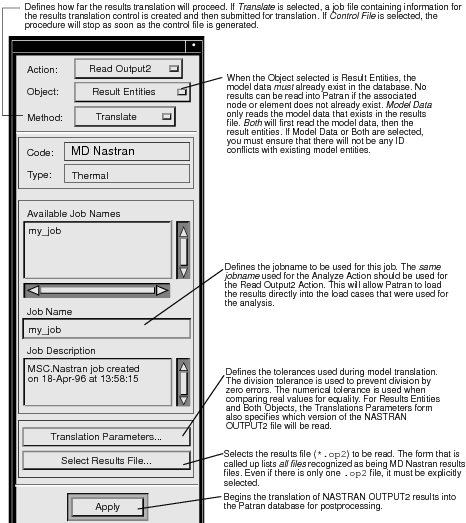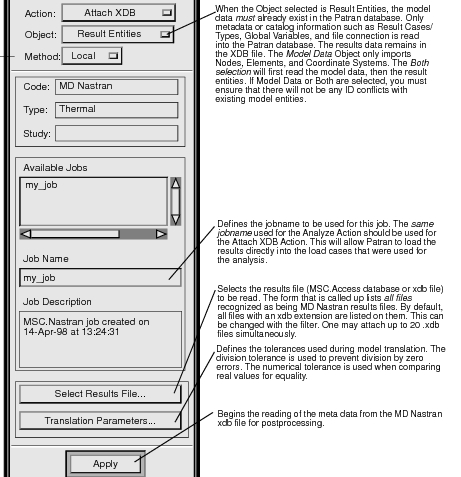XXXXXXXXXXXXXXXXXXXXXXXXXXXXXXXXXXXXXXXXXXXXXXXXXXXXXXXXXXXXXXXXXXXXXXXXXXXXXXXXXXXXXXXXXXXXXXXXXXXXXXXXXXXXXXXXXXXXXXXXXXXXXXXXXXXXXXXXXXXXXXXXXXXXXXXX''"> 5.2 Reading Thermal Analysis Results
The Analysis form will appear when you select Analysis from the main form.
There are currently two Actions--Read Output2 and Attach XDB--for importing results. Selecting Read Output2 as the Action on the Analysis form allows the model and⁄or results data to be read into the Patran database from an NASTRAN OUTPUT2 file. Subordinate forms of the Analysis form will define translation parameters, which control the data to be translated, and the OUTPUT2 file from which to translate. The OUTPUT2 data files are created by placing a PARAM,POST,-1 entry in the MD Nastran Bulk Data section.
Selecting Attach XDB as the Action on the Analysis form allows the results data from a MSC.Access database (an .xdb file) to be accessed. In this case the results are not read directly into the Patran database but instead remain in the MSC.Access database. Only what is termed as meta data is read into the Patran database. Meta data consists of the Result Case names, their associated subcases, primary and secondary result types, global variables, and the file location of the MSC.Access database or .xdb file. The Meta data is used to translate results when the user attempts to postprocess the model. Subordinate forms of the Analysis form will define translation parameters, which control the data to be accessed on attachment. MSC.Access databases are created by placing a PARAM,POST,0 entry in the MD Nastran Bulk Data section.

Read Output2 Form
This form appears when you select Analysis from the main menu. Read Output2, as the selected Action, defines the type of data to be read from the MD Nastran results file into Patran. The Object choices are Result Entities, Model Data, or Both.

Results File Formats
The Patran MD Nastran interface supports several different OUTPUT2 file formats. The interface, running on any platform can read a binary format OUTPUT2 file produced by MD Nastran running on any of these same platforms. For example, a binary OUTPUT2 file produced by MD Nastran running on an IBM RS/6000 can be read by Patran running on DEC Alpha. Patran may be able to read binary format OUTPUT2 files from other platforms if they contain 32 bit, IEEE format entities (either Big or Little Indian).
For platforms that do not produce OUTPUT2 files in these formats, Patran can read OUTPUT2 files created with the FORM=FORMATTED option in MD Nastran. This option can be selected from the Analyze/Translation Parameters form in Patran Analysis menu and directs MD Nastran to produce an ASCII format OUTPUT2 file that can be moved between any platforms. The Patran MD Nastran interface detects this format when the OUTPUT2 file is opened, automatically converts it to the binary format, and then reads the model and/or results into the Patran database.
An OUTPUT2 file is created by MD Nastran by placing a PARAM,POST,-1 entry in the Bulk Data portion of the input file. The formatted or unformatted OUTPUT2 file is specified in the FMS section using an ASSIGN OUTPUT2 = filename, UNIT=#, FORM=FORMATTED (or UNFORMATTED) command. See
Translation Parameters, 109.
Supported OUTPUT2 Results
The following table indicates all the possible results quantities that can be loaded into the Patran database during results translation from MD Nastran. The Primary and Secondary Labels are items selected from the postprocessing menus. The Type indicates whether the results are Scalar or Vector and determines which postprocessing techniques are available to view the results quantity. Data Block indicates which NASTRAN OUTPUT2 datablock the data comes from. The Description gives a brief discussion about the results quantity, such as whether it is a nodal or elemental result, and what type of output request will generate this datablock.
Primary Level | Secondary Level | Type | Data Block | Description |
Temperatures | | S | OUGV1 | Nodal temperatures |
Applied Linear Loads | | S | OPG1 | Nodal applied linear loads |
Heats of Constraint | | S | OQG1 | Nodal heats of constraint |
Heat Flows | Applied Load | S | OEF1 | Heat flows from applied surface loads |
Free Conv | S | OEF1 | Heat flows from free convection |
Forced Conv | S | OEF1 | Heat flows from forced convection |
Radiation | S | OEF1 | Heat flows from radiation |
Total | S | OEF1 | Total heat flows into surface elems |
Temperature Gradients | | V | OEF1 | Conduction element temperature gradients |
Heat Fluxes | | V | OEF1 | Conduction element heat fluxes |
Enthalpies | | S | OUGV1 | Nodal enthalpies |
Rate of Change of Enthalpies | | S | OUGV1 | Rate of change of nodal enthalpies |
Heats of Constraint are the mathematical (non-physical) heat flow into or out of a nodal point which is associated with a user-specified temperature. In real-world analysis, we generally do not know the structural temperatures, but we do know something about the heat loads, convection and radiation boundaries, etc. We then invoke MD Nastran to calculate the temperatures. However, suppose we have results of an experiment in which a thermocouple is used to measure the boundary temperature. This temperature could then be applied as a boundary condition in the finite element model. In the experimental test, there may well be heat flow into or out of the boundary, but we have not made any attempt to qualify or quantify the heat flow mechanism because we actually measured the temperature. When the MD Nastran thermal analysis is performed, the heat of constraint output represents the heat flow that must occur at the physical boundary to support or maintain the measured temperature.
In addition to standard results quantities, several Global Variables can be created. This table outlines Global Variables that may be created. Global Variables are results quantities where one value is representative of the entire model:
Label | Type | Data Block | Description |
Time | S | Oxxx | Time value of the time step |
Percent of Load | S | Oxxx | Percent of load value for a nonlinear steady-state analysis |
When reading model data from an NASTRAN OUTPUT2 file by selecting the Model Data Object, all the data that will be created in the Patran database and the location in the OUTPUT2 file from where it is derived are described in the following table:
Item | Block | Description |
Nodes | GEOM1 | Node ID Nodal Coordinates Reference Coordinate Frame Analysis Coordinate Frame |
Coordinate Frames | GEOM1 | Coordinate Frame ID Transformation Matrix Origin Can be Rectangular, Cylindrical, or Spherical |
Elements | GEOM2 | Element ID Topology (e.g., Quad4 or Hex20) Nodal Connectivity |
Attach XDB Form
This form appears when you select Analysis from the main menu. Attach XDB, as the selected Action, defines the type of data to be read from the MD Nastran results file into Patran. The Object choices are Result Entities, Model Data, or Both.

Results File Formats
The same basic issues exist for MSC.Access databases as for OUTPUT2 files. For example, the MSC.Access database (xdb file) may be exchanged between computer systems that have binary compatibility. That is, an XDB file generated on a SUN Machine may be used on an IBM/AIX, HPUX or SGI computers.
However, in order to exchange the XDB file on binary incompatible machines, one needs to use the TRANS and RECEIVE utilities delivered with every installation of MD Nastran.
TRANS converts an XDB file generated by MD Nastran to an “equivalent” character, i.e. ASCII, file which can be transported to another computer across the network via ftp or rcp. RECEIVE converts the character file back into the XDB format for postprocessing.
For more information on TRANS and RECEIVE utilities, please consult the “Configuration and Operations Guide” for V70 of MSC.Nastran.
A MSC.Access XDB database is created by MD Nastran by placing a PARAM,POST,0 entry in the Bulk Data portion of the input file. See
Translation Parameters, 109.
In this release, it is assumed that the geometry, loads, and results ouput all reside in the same physical XDB file. That is, "split" XDB databases are not supported.
Supported MSC.Access Results
The following tables list the currently supported quantities from the MSC.Access database (xdb file). The Primary and Secondary Labels are items selected from the postprocessing menus. The Type indicates whether the results are Scalar or Vector and determines which postprocessing techniques are available to view the results quantity. The Object indicates which MSC.Access object the data comes from. The Description gives a brief discussion about the results quantity, such as whether it is a nodal or elemental result, and what type of output request will generate this datablock.
To get further information on the MSC.Access, i.e. XDB, objects supported in Patran, please use the ddlprt and ddlqry utilities delivered with every installation of MD Nastran.
ddlprt is MSC.Access' on-line documentation.
ddlqry is MSC.Access’ Data Definition Language (DDL) browser.
See “Configuration and Operations Guide” for MSC.Nastran V70.
Primary Level | Secondary Level | Type | Object | Description |
Temperatures | | S | THERR | Nodal temperatures |
Applied Linear Loads | | S | HTFLR | Nodal applied linear loads |
Heats of Constraint | | S | HTFFR | Nodal heats of constraint |
Heat Flows | Applied Load | S | QHBDY | Heat flows from applied surface loads |
Free Conv | S | QHBDY | Heat flows from free convection |
Forced Conv | S | QHBDY | Heat flows from forced convection |
Radiation | S | QHBDY | Heat flows from radiation |
Total | S | QHBDY | Total heat flows into surface elems |
Temperature Gradients | | V | QBARR, QBEMR,QCONR, QHEXR,QPENR, QQD4R, QQD8R, QRODR, QTETR, QTUBR, QTX6R | Conduction element temperature gradients |
Heat Fluxes | | V | QBARR, QBEMR, QCONR, QHEXR,QPENR, QQD4R, QQD8R, QRODR, QTETR, QTUBR, QTX6R | Conduction element heat fluxes |
Enthalpies | | S | ENTHR | Nodal enthalpies |
Rate of Change of Enthalpies | | S | ENRCR | Rate of change of nodal enthalpies |
Heats of Constraint are the mathematical (non-physical) heat flow into or out of a nodal point which is associated with a user-specified temperature. In real-world analysis, we generally do not know the structural temperatures, but we do know something about the heat loads, convection and radiation boundaries, etc. We then invoke MD Nastran to calculate the temperatures. However, suppose we have results of an experiment in which a thermocouple is used to measure the boundary temperature. This temperature could then be applied as a boundary condition in the finite element model. In the experimental test, there may well be heat flow into or out of the boundary, but we have not made any attempt to qualify or quantify the heat flow mechanism because we actually measured the temperature. When the MD Nastran thermal analysis is performed, the heat of constraint output represents the heat flow that must occur at the physical boundary to support or maintain the measured temperature.




